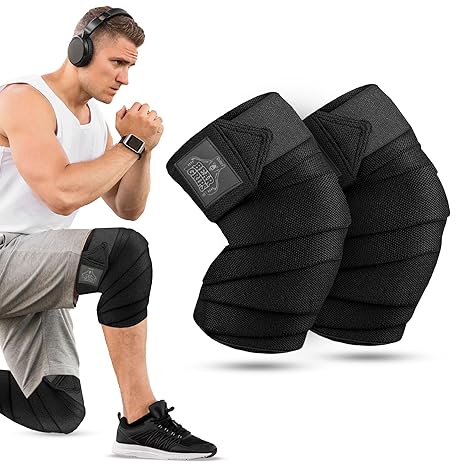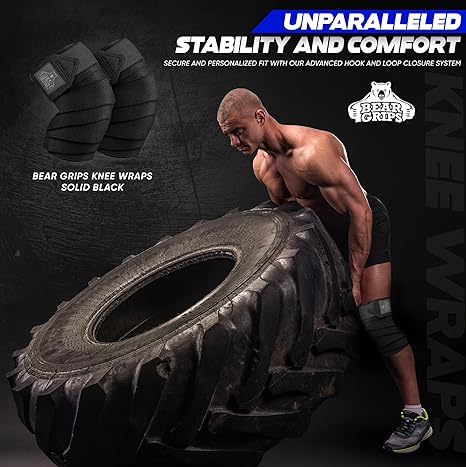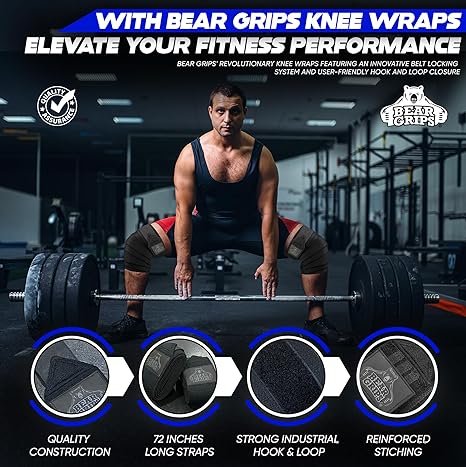
Here's Why You Need Knee Wraps
Share
If you're serious about your workouts and performance, knee wraps are an essential tool to add to your fitness arsenal. These wraps provide the stability and support your knees need to protect your joints during heavy lifting sessions.
Knee wraps are designed to enhance your performance and improve your squatting technique. The wrap pressure creates energy that allows you to lift more weight, giving you the extra push you need to reach your goals.
But knee wraps do more than just boost your performance. They also provide several other benefits, such as relieving knee pain, reducing inflammation, and minimizing swelling. By properly supporting your knee joints, knee wraps help you stay on top of your game and prevent injuries that could sideline your progress.

It's important to use knee wraps correctly and sparingly. While they are favored by powerlifters for their ability to move as much weight as possible and generate greater momentum during lifts, they can be more restrictive than knee sleeves. Reserve knee wraps for your heaviest lifts or your one-rep maximum to maximize their effectiveness.
In the following sections, we'll dive deeper into what knee wraps are, how they compare to knee sleeves, and help you make an informed decision on which option is best for your training needs.
What are Knee Wraps?
Knee wraps are compression-type wraps that provide support and stability to the knee joints. They help ease tension and stress on the knees and quadricep muscles. Made of elastic material, knee wraps are longer in length (typically 72 inches or longer) than wrist wraps. They have gained popularity for improving knee safety during heavy workouts such as squats or leg press movements. The most common exercise in which knee wraps are used is squats, but they can also be used for leg press, deadlift, and other squat variations.
When wrapped tightly around the knee joint, knee wraps create a supportive and stabilizing effect, helping to reduce the risk of injury and enhance performance. The elastic nature of the wraps provides a level of tension that supports the knee joint and allows for better force production during exercises. This added stability can improve lifting ability and protect the knees from excessive stress, especially when lifting heavy weights.

By providing external support to the knee joints, knee wraps help to distribute forces more evenly, relieving pressure on the knee and quadriceps muscles. This can help to minimize the risk of overuse injuries, such as patellar tendinitis, and reduce the likelihood of knee pain and inflammation during and after workouts.
"Knee wraps are essential for powerlifters and strength athletes who perform heavy compound exercises that place high demand on the knee joints. They provide the necessary support and stability, allowing us to lift heavier weights and push our limits safely."
In addition to their supportive and protective benefits, knee wraps can also enhance performance by allowing the lifter to generate more power and utilize greater muscle activation. The tension created by the wraps can help store energy in the elastic material, which is then released during the concentric phase of the lift, adding to the force produced by the muscles.
The Benefits of Knee Wraps:
- Provide support and stability to the knee joints
- Help ease tension and stress on the knees and quadricep muscles
- Improve knee safety during heavy workouts
- Enhance lifting ability and performance
- Reduce the risk of overuse injuries and knee pain
- Allow for greater muscle activation and power generation
If you're a powerlifter, weightlifter, or anyone performing heavy compound exercises, using knee wraps can greatly benefit your training. However, it's important to learn the proper wrapping technique and avoid relying on knee wraps for every workout. Knee wraps should be used selectively for the heaviest lifts or one rep maximum, while focusing on developing overall strength, mobility, and proper lifting form.
| Knee Wraps | Knee Sleeves |
|---|---|
| Provide support and stability during heavy lifts | Offer support and compression for various activities |
| Help generate more power and momentum | Reduce the risk of injury and provide warmth |
| Longer in length, typically 72 inches or longer | Shorter in length, covering the knee joint |
| Preferred by powerlifters | Used by athletes in various sports |
Knee Wraps vs. Knee Sleeves
Knee wraps and knee sleeves offer different benefits and are used in different ways. Powerlifters often prefer knee wraps because they allow them to move as much weight as possible by providing additional support and storing energy for greater momentum during lifts. In addition to enhancing performance, knee wraps also offer knee pain relief and help reduce pressure and strain on the quadriceps tendons.
On the other hand, knee sleeves are designed to provide support, warmth, and compression throughout various activities, reducing the risk of injury. While they may not offer the same level of energy storage and momentum as knee wraps, knee sleeves are more versatile and commonly used in a wide range of athletic pursuits, including running, basketball, and volleyball.

Ultimately, the choice between knee wraps and knee sleeves depends on individual needs and training goals. Powerlifters who prioritize moving heavier weights and maximizing energy transfer may opt for knee wraps, while athletes engaged in diverse activities may find knee sleeves to be a more suitable option due to their broader functionality and injury prevention capabilities.
Conclusion
In conclusion, investing in knee wraps can greatly benefit individuals who are looking to lift heavier weights and improve their squatting technique. Knee wraps provide crucial support and stability during intense workouts, offering pain relief and reducing the risk of injury. However, it is important to use knee wraps correctly and sparingly to avoid dependency and potential limitations in mobility.
On the other hand, knee sleeves offer a versatile solution for individuals engaged in various activities, providing support, warmth, and compression. They can be used as a preventive measure to reduce the risk of injuries during exercises such as running, basketball, and volleyball.
When choosing between knee wraps and knee sleeves, it is essential to consider individual needs and goals. For powerlifters and those focused on heavy lifting, knee wraps offer the advantage of increased energy storage and greater momentum. Alternatively, knee sleeves are better suited for those seeking overall support and injury prevention in different activities.
While knee wraps and knee sleeves provide valuable assistance, it is important not to solely rely on these supportive gears. Prioritizing proper form, mobility exercises, and strength training should always be the foundation of any fitness journey. By combining these elements with the appropriate use of knee wraps or knee sleeves, individuals can maximize their performance, minimize the risk of injury, and achieve their fitness goals.
Bear Grips has the best gym knee wraps. Check them out now!
or Shop at AMAZON.COM now!
FAQ
Are knee wraps worth the investment?
Yes, knee wraps are worth the investment as they allow you to lift more weight and improve squatting technique through the energy created by the wrap pressure. They provide benefits such as knee pain relief, reduced inflammation, and reduced swelling.
What are knee wraps?
Knee wraps are compression-type wraps that provide support and stability to the knee joints. They help ease tension and stress on the knees and quadricep muscles. Made of elastic material, knee wraps are longer in length (typically 72 inches or longer) than wrist wraps.
How do knee wraps compare to knee sleeves?
Knee wraps are preferred by powerlifters because they help move as much weight as possible by storing more energy and providing greater momentum during lifts. They also provide knee pain relief and reduce pressure and strain on the quadriceps tendons. Knee sleeves, on the other hand, provide support, warmth, and compression throughout activities, reducing the risk of injury.
Can knee wraps be used for exercises other than squats?
Yes, knee wraps can be used for exercises such as leg press, deadlift, and other squat variations. However, they are typically used for the heaviest lifts or one rep maximum.
What should be considered when choosing between knee wraps and knee sleeves?
Knee wraps are designed to enhance and support heavy lifting, while knee sleeves offer support, warmth, and compression for various activities. The choice should be based on individual needs and training goals.


